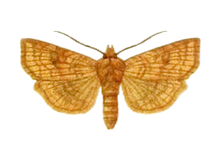Xestia
| Xestia | |
|---|---|
 |
|
| Xestia ochreago, the type species | |
| Scientific classification | |
| Kingdom: | Animalia |
| Phylum: | Arthropoda |
| Class: | Insecta |
| Order: | Lepidoptera |
| Family: | Noctuidae |
| Subfamily: | Noctuinae |
| Tribe: | Xestiini (disputed) |
| Genus: |
Xestia Hübner, 1818 |
| Type species | |
|
Noctua ochreago Hübner, 1790 |
|
| Diversity | |
| Probably over 100 species (but see text) |
|
| Synonyms | |
|
Numerous, see text |
|
Numerous, see text
Xestia is a genus of noctuid moths (family Noctuidae). They are the type genus of the tribe Xestiini in subfamily Noctuinae, though some authors merge this tribe with the Noctuini. Species in this genus are commonly known as "", "" or "rustic", but such names are commonplace among Noctuidae. Xestia moths have a wide distribution, though they most prominently occur in the Holarctic.
With almost 200 species included at one time, Xestia was something of a "wastebin genus". But almost half of the traditional species are nowadays placed elsewhere (see below), and some of the remaining ones are liable to be assigned to another genus also. On the other hand, new moths that probably in fact belong into this genus are still being discovered regularly or so (e.g. X. hypographa, which led to the 2002 transfer of X. ornata from Eugraphe to here). Thus, unless there are drastic taxonomic changes in the future, Xestia is likely to remain one of the larger noctuine genera.
Xestia adults are usually of medium size and robust build, with stout hairy bodies and strong wings. Some are quite colorful moths, with bold lighter markings and hindwings in delicate yellowish, reddish or bluish hues. Generally, they are cryptic while at rest however, with unmarked pale or dull brownish hindwings; they do not have metallic hues and few species possess obvious eyespots.
This genus includes many species living at high latitudes and altitudes, in tundra and taiga ecosystems. Some have two-year (semivoltine) life-cycles and only occur as adults every other year; typically the caterpillar larva overwinters to pupate in spring, with the moths flying around midsummer, but some species eclose later, their moths flying from late summer into autumn. Xestia caterpillars are generally stout and cryptically colored; in some species they have quite prominent dark lengthwise spots, but may e.g. be entirely green or whatever else gives best camouflage.
...
Wikipedia
